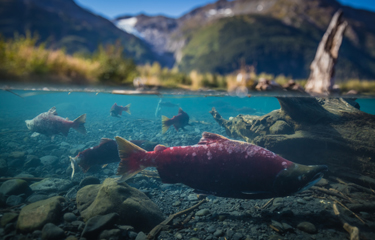The world’s largest sockeye fishery, Bristol Bay, Alaska, clocked its second-largest harvest ever this season, with a haul of more than 43 million fish. The big catch, combined with a robust base price – most of the fishery’s major processors have posted an initial ex-vessel buying price at USD 1.35 (EUR 1.20) per pound – should make 2019 among the most lucrative years in the fishery’s history. This season’s historic catch comes after a string of abnormally large runs, including last season’s 62.3 million salmon, the largest in Bristol Bay’s history.
But despite a string of productive runs that have surpassed forecasts, some biologists and fishermen are concerned about warm, dry weather that has pumped up water temperatures in the region.
Daniel Schindler, a University of Washington fisheries ecologist who spends his summers at a research station in Bristol Bay, said that while he and his team have not completed their 2019 temperature data, he estimates that salmon-bearing lakes and streams will be about two degrees Celsius warmer than normal and likely the warmest on record.
Schindler added that the uncharacteristic hot, calm weather that dominated much of July meant that the deep cold water in lakes did not get stirred up, causing a layer of hot water – over 70 degrees Fahrenheit in some cases – that sloughed off into the rivers.
Water temperatures out in Bristol Bay were shockingly high as well, with one fleet manager from a major processor telling SeafoodSource that a tender had registered 71 degrees Fahrenheit at nine feet down at Clarks’ Point in the Nushagak District.
The hot summer got a running start after the Bering Sea labored through a second straight season of record-low sea ice.
“Last year was unprecedented, and then it happened again. We didn’t expect it to happen so soon. We thought maybe the northern Bering Sea would ice-free in 50 years and then it happened two winters in a row. It’s astonishing,” said Elizabeth Siddon, a NOAA biologist who specializes in cod and pollock stocks in the Bering Sea.
The mild winter led to pre-season sea surface temperatures around Bristol Bay that were around one degree Celsius above historical averages, according to the ADF&G in Dillingham. Area biologists from Alaska Department of Fish & Game are still compiling temperature data bases for the season, but fishermen across the fishery’s four major districts reported water temperatures over 70 degrees Fahrenheit. Salmon die-offs, which biologists believe are caused by a lack of oxygen in warm water, were reported in several watersheds where rivers and streams run flat and slow.
Catie Bursch, a Ugashik set-netter who has been fishing the district for 30 years, said he thinks the run in Ugashik was held up because temperatures were too warm for the fish to move up the river.
“There was a definite thermal barrier. The fish just kept pumping into Ugashik Bay and just wouldn’t go up the river. We saw jumpers for 12 days straight and they just milled and milled and milled. Eventually temperatures went down, we got a westerly wind, and they moved,” said Bursch, adding that she has pictures and video of dead fish drifting out of Ugashik tributaries.
But while Ugashik caught just a million fish on a forecast of 2.4 million, most other districts far exceeded their forecasts, with both the Nushagak and Egegik districts nearly doubling pre-season estimates from ADF&G.
Tim Sands, ADF&G’s area management biologist for the Nushagak, said the warm, dry summer weather is not helping the fish, but he hypothesized that milder winters may be giving fish more time to mature in the lakes before they hit the ocean, therefore increasing their chances of survival.
But other biologists fear that if summer water temperatures keep rising, incidents like the die-offs or the possible thermal blocking the occurred on the Ugashik may damage runs.
The lack of rain is also a concern. While Schindler reported he was seeing healthy fish and no abnormal pre-spawn mortality at his research station, he did say that some fish were having trouble accessing some of the more shallow spawning streams.
Photo courtesy of Shutterstock







